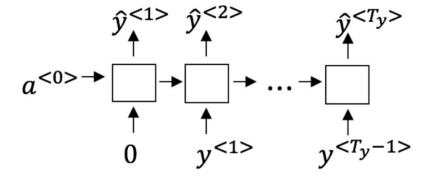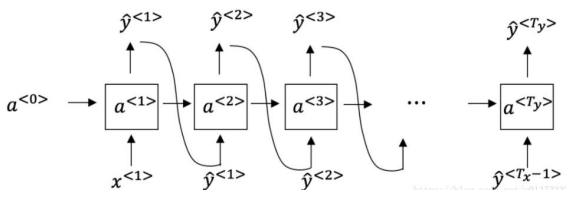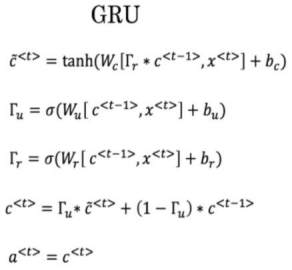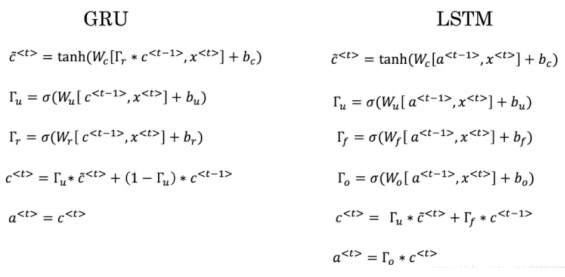吴恩达《深度学习》-课后测验-第五门课 序列模型(Sequence Models)-Week 1: Recurrent Neural Networks(第一周测验:循环神经网络)
Week 1 Quiz: Recurrent Neural Networks(第一周测验:循环神经网络)
\1. Suppose your training examples are sentences (sequences of words). Which of the following refers to the jth word in the ith training example?( 假设你的训练样本是句子(单词序列),下 面哪个选项指的是第𝑖个训练样本中的第𝑗个词?)
【 】 $𝑥^{(𝑖)<𝑗>} $
【 】 \(𝑥^{<𝑖>(𝑗) }\)
【 】 \(𝑥^{(𝑗)<𝑖>}\)
【 】 \(𝑥^{<𝑗>(𝑖)}\)
答案
【★】 𝑥(𝑖)<𝑗> (注:首先获取第𝑖个训练样本(用括号表示),然后到𝑗列获取单词(用括尖括号表示)。)
\2. Consider this RNN: This specific type of architecture is appropriate when: (看一下下面的这 个循环神经网络:在下面的条件中,满足上图中的网络结构的参数是)

【 】$𝑇_𝑥 = 𝑇_𝑦 $
【 】 $𝑇_𝑥 < 𝑇_𝑦 $
【 】\(𝑇_𝑥 > 𝑇_𝑦\)
【 】$ 𝑇_𝑥 = 1 $
答案
【★】𝑇𝑥 = 𝑇𝑦
\3. To which of these tasks would you apply a many-to-one RNN architecture? (Check all that apply). (上图中每一个输入都与输出相匹配。 这些任务中的哪一个会使用多对一的 RNN 体 系结构?)
【 】 Speech recognition (input an audio clip and output a transcript) (语音识别(输入语音, 输出文本)。)
【 】 Sentiment classification (input a piece of text and output a 0/1 to denote positive or negative sentiment) (情感分类(输入一段文字,输出 0 或 1 表示正面或者负面的情绪)。)
【 】Image classification (input an image and output a label) (图像分类(输入一张图片,输出 对应的标签)。)
【 】 Gender recognition from speech (input an audio clip and output a label indicating the speaker’s gender) (人声性别识别(输入语音,输出说话人的性别)。)
答案
【★】 Sentiment classification (input a piece of text and output a 0/1 to denote positive or negative sentiment) (情感分类(输入一段文字,输出 0 或 1 表示正面或者负面的情绪)。)
【★】 Gender recognition from speech (input an audio clip and output a label indicating the speaker’s gender) (人声性别识别(输入语音,输出说话人的性别)。)
\4. You are training this RNN language model.

At the \(𝑡^{th}\) time step, what is the RNN doing? Choose the best answer.( 假设你现在正在训练下面 这个 RNN 的语言模型: 在𝑡时,这个 RNN 在做什么?)
【 】 Estimating 𝑃(\(𝑦^{<1>}, 𝑦^{<2>},… , 𝑦^{<𝑡−1>}\))( 计算 𝑃(\(𝑦^{<1>}, 𝑦^{<2>},… , 𝑦^{<𝑡−1>}\)) )
【 】 Estimating 𝑃(\(𝑦^{<𝑡>}\)) (计算 𝑃(\(𝑦^{<𝑡>}\)) )
【 】Estimating \(𝑃(𝑦 ∣ 𝑦^{<1>}, 𝑦^{<2>},… , 𝑦^{<𝑡>})\) ( 计算 \(𝑃(𝑦 ∣ 𝑦^{<1>}, 𝑦^{<2>},… , 𝑦^{<𝑡>})\))
【 】Estimating \(𝑃(𝑦 ∣ 𝑦^{<1>}, 𝑦^{<2>}, … , 𝑦^{<𝑡−1>})\)( 计算 \(𝑃(𝑦 ∣ 𝑦^{<1>}, 𝑦^{<2>}, … , 𝑦^{<𝑡−1>})\))
答案
Yes,in a language model we try to predict the next step based on the knowledge of all prior steps
【★】Estimating 𝑃(𝑦 ∣ 𝑦 <1>, 𝑦 <2>,… , 𝑦 <𝑡>) ( 计算 𝑃(𝑦 ∣ 𝑦 <1>, 𝑦 <2>, … , 𝑦 <𝑡-1>) )
\5. You have finished training a language model RNN and are using it to sample random sentences, as follows: What are you doing at each time step 𝑡?( 你已经完成了一个语言模型 RNN 的训练,并用它来对句子进行随机取样,如下图: 在每个时间步𝑡都在做什么?)

【 】Use the probabilities output by the RNN to pick the highest probability word for that time-step as \(𝑦^{<𝑡>}\). (ii) Then pass the ground-truth word from the training set to the next timestep. ((1)使用 RNN 输出的概率,选择该时间步的最高概率单词作为\(𝑦^{<𝑡>}\),(2)然后将训练集中 的正确的单词传递到下一个时间步。)
【 】Use the probabilities output by the RNN to randomly sample a chosen word for that time-step as \(𝑦^{<𝑡>}\). (ii) Then pass the ground-truth word from the training set to the next timestep. ((1)使用由 RNN 输出的概率将该时间步的所选单词进行随机采样作为 \(𝑦^{<𝑡>}\),(2)然后将训 练集中的实际单词传递到下一个时间步。)
【 】Use the probabilities output by the RNN to pick the highest probability word for that time-step as \(𝑦^{<𝑡>}\). (ii) Then pass this selected word to the next time-step. ((1)使用由 RNN 输出 的概率来选择该时间步的最高概率词作为 \(𝑦^{<𝑡>}\),(2)然后将该选择的词传递给下一个时间步。)
【 】 Use the probabilities output by the RNN to randomly sample a chosen word for that time-step as \(𝑦^{<𝑡>}\). (ii) Then pass this selected word to the next time-step. ((1)使用 RNN 该时间 步输出的概率对单词随机抽样的结果作为\(𝑦^{<𝑡>}\),(2)然后将此选定单词传递给下一个时间步。)
答案
【★】 (i) Use the probabilities output by the RNN to randomly sample a chosen word for that time-step as 𝑦 <𝑡>. (ii) Then pass this selected word to the next time-step. ((1)使用 RNN 该时间 步输出的概率对单词随机抽样的结果作为𝑦 <𝑡>,(2)然后将此选定单词传递给下一个时间步。)
\6. You are training an RNN, and find that your weights and activations are all taking on the value of NaN (“Not a Number”). Which of these is the most likely cause of this problem?
【 】 Vanishing gradient problem. (梯度消失。)
【 】Exploding gradient problem. (梯度爆炸。)
【 】 ReLU activation function g(.) used to compute g(z), where z is too large. (ReLU 函数作为 激活函数𝑔(. ),在计算𝑔(𝑧)时,𝑧的数值过大了。)
【 】 Sigmoid activation function g(.) used to compute g(z), where z is too large. (Sigmoid 函数 作为激活函数𝑔(. ),在计算𝑔(𝑧)时,𝑧的数值过大了。)
答案
【★】Exploding gradient problem. (梯度爆炸。)
7.Suppose you are training a LSTM. You have a 10000 word vocabulary, and are using an LSTM with 100-dimensional activations a. What is the dimension of Γu at each time step?( 假设你正 在训练一个 LSTM 网络,你有一个 10,000 词的词汇表,并且使用一个激活值维度为 100 的 LSTM 块,在每一个时间步中,𝛤𝑢的维度是多少?)
【 】 1
【 】 100
【 】300
【 】 10000
答案
【★ 】 100
(注: 𝛤𝑢的向量维度等于 LSTM 中隐藏单元的数量。)
\8. Here’re the update equations for the GRU. Alice proposes to simplify the GRU by always removing the \(𝛤_𝑢\). I.e., setting \(𝛤_𝑢\) = 1. Betty proposes to simplify the GRU by removing the \(𝛤_𝑟\) . I. e., setting \(𝛤_𝑟\)=1 always. Which of these models is more likely to work without vanishing gradient problems even when trained on very long input sequences?( 这里有一些 GRU 的更新方程: 爱丽丝建议通过移除\(𝛤_𝑢\)来简化 GRU, 即设置\(𝛤_𝑢\) = 1。贝蒂提出通过移除\(𝛤_𝑟\)来简化 GRU,即设置\(𝛤_𝑟\)=1。哪种模型更容易在梯度不消失问题的情况下训练,即使在很长的输入序列上也可以进行训练?)

【 】 Alice’s model (removing \(𝛤_𝑢\)), because if \(𝛤_𝑟\) ≈ 0 for a timestep, the gradient can propagate back through that timestep without much decay. (爱丽丝的模型(即移除 𝛤𝑢),因为对于一个 时间步而言,如果𝛤𝑟 ≈ 0,梯度可以通过时间步反向传播而不会衰减。)
【 】Alice’s model (removing 𝛤𝑢), because if 𝛤𝑟 ≈ 1 for a timestep, the gradient can propagate back through that timestep without much decay. (爱丽丝的模型(即移除 𝛤𝑢),因为对于一个 时间步而言,如果𝛤𝑟 ≈ 1,梯度可以通过时间步反向传播而不会衰减。)
【 】 Betty’s model (removing 𝛤𝑟 ), because if 𝛤u ≈ 0 for a timestep, the gradient can propagate back through that timestep without much decay. (贝蒂的模型(即移除𝛤𝑟),因为对于一个时间 步而言,如果𝛤u ≈ 0,梯度可以通过时间步反向传播而不会衰减。)
【 】Betty’s model (removing 𝛤𝑟 ), because if 𝛤u ≈ 1 for a timestep, the gradient can propagate back through that timestep without much decay. (贝蒂的模型(即移除𝛤𝑟),因为对于一个时 间步而言,如果𝛤u ≈ 1,梯度可以通过时间步反向传播而不会衰减。)
答案
【★ 】 Betty’s model (removing 𝛤𝑟 ), because if 𝛤u ≈ 0 for a timestep, the gradient can propagate back through that timestep without much decay. (贝蒂的模型(即移除𝛤𝑟),因为对于一个时间 步而言,如果𝛤u ≈ 0,梯度可以通过时间步反向传播而不会衰减。)
(注:要使信号反向传播而不消失,我们需要𝑐 <𝑡>高度依赖于𝑐 <𝑡−1>。)
\9. Here are the equations for the GRU and the LSTM: From these, we can see that the Update Gate and Forget Gate in the LSTM play a role similar to _ and __ in the GRU. What should go in the the blanks?( 这里有一些 GRU 和 LSTM 的方程: 从这些 我们可以看到,在 LSTM 中的更新门和遗忘门在 GRU 中扮演类似___与___的角色,空白处应该 填什么?)

【 】𝛤𝑢 与 1 − 𝛤𝑢 (𝛤𝑢 与 1 − 𝛤𝑢 )
【 】𝛤𝑢与 𝛤𝑟 (𝛤𝑢与 𝛤𝑟 )
【 】1 − 𝛤𝑢 与𝛤𝑢 (1 − 𝛤𝑢 与𝛤𝑢 )
【 】𝛤𝑟 与𝛤𝑢 (𝛤𝑟 与𝛤𝑢 )
答案
【★】𝛤𝑢 与 1 − 𝛤𝑢 (𝛤𝑢 与 1 − 𝛤𝑢 )
\10. You have a pet dog whose mood is heavily dependent on the current and past few days’ weather. You’ve collected data for the past 365 days on the weather, which you represent as a sequence as \(𝑥^{<1>},… , 𝑥^{<365>}\). You’ve also collected data on your dog’s mood, which you represent as \(𝑦^{<1>}, … , 𝑦^{<365>}\). You’d like to build a model to map from x→y. Should you use a Unidirectional RNN or Bidirectional RNN for this problem?( 你有一只宠物狗,它的心情很大 程度上取决于当前和过去几天的天气。你已经收集了过去 365 天的天气数据 \(𝑥^{<1>},… , 𝑥^{<365>}\),这些数据是一个序列,你还收集了你的狗心情的数据\(𝑦^{<1>}, … , 𝑦^{<365>}\),你想建立一个模型来从𝑥到𝑦进行映射,你应该使用单向 RNN 还是双向 RNN 来解决这个问 题?)
【 】Bidirectional RNN, because this allows the prediction of mood on day 𝑡 to take into account more information. (双向 RNN,因为在𝑡日的情绪预测中可以考虑到更多的信息。)
【 】 Bidirectional RNN, because this allows backpropagation to compute more accurate gradients.( 双向 RNN,因为这允许反向传播计算中有更精确的梯度。)
【 】 Unidirectional RNN, because the value of \(𝑦^{<𝑡>}\) depends only on \(𝑥^{<1>},… , 𝑥^{<𝑡>}\) ,but not on \(𝑥^{<𝑡+1>},… , 𝑥^{<365>}\) (单向 RNN,因为\(𝑦^{<𝑡>}\)的值仅依赖于\(𝑥^{<1>},… , 𝑥^{<𝑡>}\),而不依赖于 \(𝑥^{<𝑡+1>},… , 𝑥^{<365>}\)。)
【 】Unidirectional RNN, because the value of \(𝑦^{<𝑡>}\) depends only on \(𝑥^{<𝑡>}\), and not other days’ weather.( 单向 RNN,因为\(𝑦^{<𝑡>}\)的值只取决于\(𝑥^{<𝑡>}\),而不是其他天的天气。)
答案
【★】 Unidirectional RNN, because the value of 𝑦 <𝑡> depends only on 𝑥 <1>,… , 𝑥 <𝑡> ,but not on 𝑥 <𝑡+1>,… , 𝑥 <365> (单向 RNN,因为𝑦 <𝑡>的值仅依赖于𝑥 <1>,… , 𝑥 <𝑡>,而不依赖于 𝑥 <𝑡+1>,… , 𝑥 <365>。)


 浙公网安备 33010602011771号
浙公网安备 33010602011771号